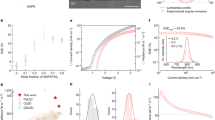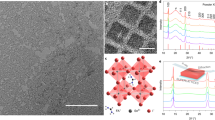Abstract
The remarkable performance of lead halide perovskites in solar cells can be attributed to the long carrier lifetimes and low non-radiative recombination rates, the same physical properties that are ideal for semiconductor lasers. Here, we show room-temperature and wavelength-tunable lasing from single-crystal lead halide perovskite nanowires with very low lasing thresholds (220 nJ cm−2) and high quality factors (Q ∼ 3,600). The lasing threshold corresponds to a charge carrier density as low as 1.5 × 1016 cm−3. Kinetic analysis based on time-resolved fluorescence reveals little charge carrier trapping in these single-crystal nanowires and gives estimated lasing quantum yields approaching 100%. Such lasing performance, coupled with the facile solution growth of single-crystal nanowires and the broad stoichiometry-dependent tunability of emission colour, makes lead halide perovskites ideal materials for the development of nanophotonics, in parallel with the rapid development in photovoltaics from the same materials.
This is a preview of subscription content, access via your institution
Access options
Subscribe to this journal
Receive 12 print issues and online access
$259.00 per year
only $21.58 per issue
Buy this article
- Purchase on Springer Link
- Instant access to full article PDF
Prices may be subject to local taxes which are calculated during checkout





Similar content being viewed by others
References
Yan, R. X., Gargas, D. & Yang, P. D. Nanowire photonics. Nature Photon. 3, 569–576 (2009).
Huang, M. H. et al. Room-temperature ultraviolet nanowire nanolasers. Science 292, 1897–1899 (2001).
Johnson, J. C. et al. Single gallium nitride nanowire lasers. Nature Mater. 1, 106–110 (2002).
Qian, F. et al. Multi-quantum-well nanowire heterostructures for wavelength-controlled lasers. Nature Mater. 7, 701–706 (2008).
Agarwal, R., Barrelet, C. J. & Lieber, C. M. Lasing in single cadmium sulfide nanowire optical cavities. Nano Lett. 5, 917–920 (2005).
Pan, A. et al. Continuous alloy-composition spatial grading and superbroad wavelength-tunable nanowire lasers on a single chip. Nano Lett. 9, 784–788 (2009).
Saxena, D. et al. Optically pumped room-temperature GaAs nanowire lasers. Nature Photon. 7, 963–968 (2013).
Hua, B., Motohisa, J., Kobayashi, Y., Hara, S. & Fukui, T. Single GaAs/GaAsP coaxial core-shell nanowire lasers. Nano Lett. 9, 112–116 (2009).
Chen, R. et al. Nanolasers grown on silicon. Nature Photon. 5, 170–175 (2011).
Wang, Z. et al. Polytypic InP nanolaser monolithically integrated on (001) silicon. Nano Lett. 13, 5063–5069 (2013).
Mayer, B. et al. Lasing from individual GaAs–AlGaAs core–shell nanowires up to room temperature. Nature Commun. 4, 2931 (2013).
Duan, X., Huang, Y., Agarwal, R. & Lieber, C. M. Single-nanowire electrically driven lasers. Nature 421, 241–245 (2003).
Kojima, A., Teshima, K., Shirai, Y. & Miyasaka, T. Organometal halide perovskites as visible-light sensitizers for photovoltaic cells. J. Am. Chem. Soc. 131, 6050–6051 (2009).
Lee, M. M., Teuscher, J., Miyasaka, T., Murakami, T. N. & Snaith, H. J. Efficient hybrid solar cells based on meso-superstructured organometal halide perovskites. Science 338, 643–647 (2012).
Liu, M., Johnston, M. B. & Snaith, H. J. Efficient planar heterojunction perovskite solar cells by vapour deposition. Nature 501, 395–398 (2013).
Burschka, J. et al. Sequential deposition as a route to high-performance perovskite-sensitized solar cells. Nature 499, 316–319 (2013).
Zhou, H. et al. Interface engineering of highly efficient perovskite solar cells. Science 345, 542–546 (2014).
Stranks, S. D. et al. Electron–hole diffusion lengths exceeding 1 micrometer in an organometal trihalide perovskite absorber. Science 342, 341–344 (2013).
Xing, G. et al. Long-range balanced electron- and hole-transport lengths in organic–inorganic CH3NH3PbI3 . Science 342, 344–347 (2013).
Deschler, F. et al. High photoluminescence efficiency and optically pumped lasing in solution-processed mixed halide perovskite semiconductors. J. Phys. Chem. Lett. 5, 1421–1426 (2014).
Tan, Z. K. et al. Bright light-emitting diodes based on organometal halide perovskite. Nature Nanotech. 9, 687–692 (2014).
Xing, G. et al. Low-temperature solution-processed wavelength-tunable perovskites for lasing. Nature Mater. 13, 476–480 (2014).
Sutherland, B. R., Hoogland, S., Adachi, M. M., Wong, C. T. & Sargent, E. H. Conformal organohalide perovskites enable lasing on spherical resonators. ACS Nano 8, 10947–10952 (2014).
Zhang, Q., Ha, S. T., Liu, X., Sum, T. C. & Xiong, Q. Room-temperature near-infrared high-q perovskite whispering-gallery planar nanolasers. Nano Lett. 14, 5995–6001 (2014).
Meng, F., Morin, S. A., Forticaux, A. & Jin, S. Screw dislocation driven growth of nanomaterials. Acc. Chem. Res. 46, 1616–1626 (2013).
Poglitsch, A. & Weber, D. Dynamic disorder in methylammonium-trihalogeno-plumbates (II) observed by millimeter-wave spectroscopy. J. Chem. Phys. 87, 6373–6378 (1987).
Liang, K., Mitzi, D. B. & Prikas, M. T. Synthesis and characterization of organic–inorganic perovskite thin films prepared using a versatile two-step dipping technique. Chem. Mater. 10, 403–411 (1998).
Morin, S. A., Bierman, M. J., Tong, J. & Jin, S. Mechanism and kinetics of spontaneous nanotube growth driven by screw dislocations. Science 328, 476–480 (2010).
Bierman, M. J., Lau, Y. K. A., Kvit, A. V., Schmitt, A. L. & Jin, S. Dislocation-driven nanowire growth and Eshelby Twist. Science 320, 1060–1063 (2008).
Li, L. et al. Facile solution synthesis of α-FeF3 ⋅ 3H2O nanowires and their conversion to α-Fe2O3 nanowires for photoelectrochemical application. Nano Lett. 12, 724–731 (2012).
Casperson, L. W. Threshold characteristics of multimode laser oscillators. J. Appl. Phys. 46, 5194–5201 (1975).
van Vugt, L. K., Ruhle, S. & Vanmaekelbergh, D. Phase-correlated nondirectional laser emission from the end facets of a ZnO nanowire. Nano Lett. 6, 2707–2711 (2006).
Johnson, J. C., Yan, H. Q., Yang, P. D. & Saykally, R. J. Optical cavity effects in ZnO nanowire lasers and waveguides. J. Phys. Chem. B 107, 8816–8828 (2003).
Eliseev, P. G. & Shuikin, N. N. Single-mode and single-frequency injection lasers (review). Sov. J. Quant. Electron. 3, 181–192 (1973).
Ning, C. Z. in Semiconductors and Semimetals Vol. 86 (eds Coleman, J. J., Bryce, A. C. & Jagadish, C.) 455–486 (Academic Press, 2012).
Snaith, H. J. et al. Anomalous hysteresis in perovskite solar cells. J. Phys. Chem. Lett. 5, 1511–1515 (2014).
Wu, X. et al. Trap States in lead iodide perovskites. J. Am. Chem. Soc. 137, 2089–2096 (2015).
Haruyama, J., Sodeyama, K., Han, L. & Tateyama, Y. Termination dependence of tetragonal CH3NH3PbI3 surfaces for perovskite solar cells. J. Phys. Chem. Lett. 5, 2903–2909 (2014).
Saba, M. et al. Correlated electron–hole plasma in organometal perovskites. Nature Commun. 5, 5049 (2014).
Svelto, O. Principles of Lasers 4th edn (Springer, 1998).
Li, H. Y., Ruhle, S., Khedoe, R., Koenderink, A. F. & Vanmaekelbergh, D. Polarization, microscopic origin, and mode structure of luminescence and lasing from single ZnO nanowires. Nano Lett. 9, 3515–3520 (2009).
Wang, J., Gudiksen, M. S., Duan, X., Cui, Y. & Lieber, C. M. Highly polarized photoluminescence and photodetection from single indium phosphide nanowires. Science 293, 1455–1457 (2001).
Shan, C. X., Liu, Z. & Hark, S. K. Photoluminescence polarization in individual CdSe nanowires. Phys. Rev. B 74, 153402 (2006).
Collin, R. E. Field Theory of Guided Waves (Wiley-IEEE Press, 1991).
Acknowledgements
X-Y.Z. acknowledges support by the US Department of Energy under grant No. ER46980 for all lasing and photophysical measurements. S.J. acknowledges support by the Department of Energy under grant No. ER46664 for NW synthesis and characterizations. S.J. is also grateful for the support of an NSF Grant (DMR-1106184) that provided the insights for designing the NW synthesis here. H.Z. thanks C. Nelson for help with experimental set-up and data analysis.
Author information
Authors and Affiliations
Contributions
H.Z., Y.F., S.J. and X-Y.Z. conceived the idea and designed the experiments. Y.F., F.M. and Q.D. synthesized and characterized the samples. H.Z., X.W. and Z.G. conducted the optical measurements. M.V.G. helped with metal-coated sample preparation and M.T.T. with experimental set-up for lasing measurement. H.Z. analysed the data and performed the simulation. H.Z., Y.F., S.J. and X-Y.Z. wrote the manuscript. All authors discussed the results, interpreted the findings, and reviewed the manuscript.
Corresponding authors
Ethics declarations
Competing interests
The authors declare no competing financial interests.
Supplementary information
Supplementary Information
Supplementary Information (PDF 3875 kb)
Rights and permissions
About this article
Cite this article
Zhu, H., Fu, Y., Meng, F. et al. Lead halide perovskite nanowire lasers with low lasing thresholds and high quality factors. Nature Mater 14, 636–642 (2015). https://doi.org/10.1038/nmat4271
Received:
Accepted:
Published:
Issue Date:
DOI: https://doi.org/10.1038/nmat4271
This article is cited by
-
Inorganic perovskite-based active multifunctional integrated photonic devices
Nature Communications (2024)
-
Single-photon superradiance in individual caesium lead halide quantum dots
Nature (2024)
-
Electronic and Mechanical Properties of High-Spin-Polarized Perovskite Compounds Cs2XYF6 (X = K, Ti and Tl, Y=Fe and V)
Journal of Superconductivity and Novel Magnetism (2024)
-
Investigation of structural, electronic, optical and elastic properties of Li-based halide perovskites LiXCl3 (X = Ca, Ba) via DFT computations
Optical and Quantum Electronics (2024)
-
Ultrafast optical investigation of carrier and spin dynamics in low-dimensional perovskites
Science China Technological Sciences (2024)



